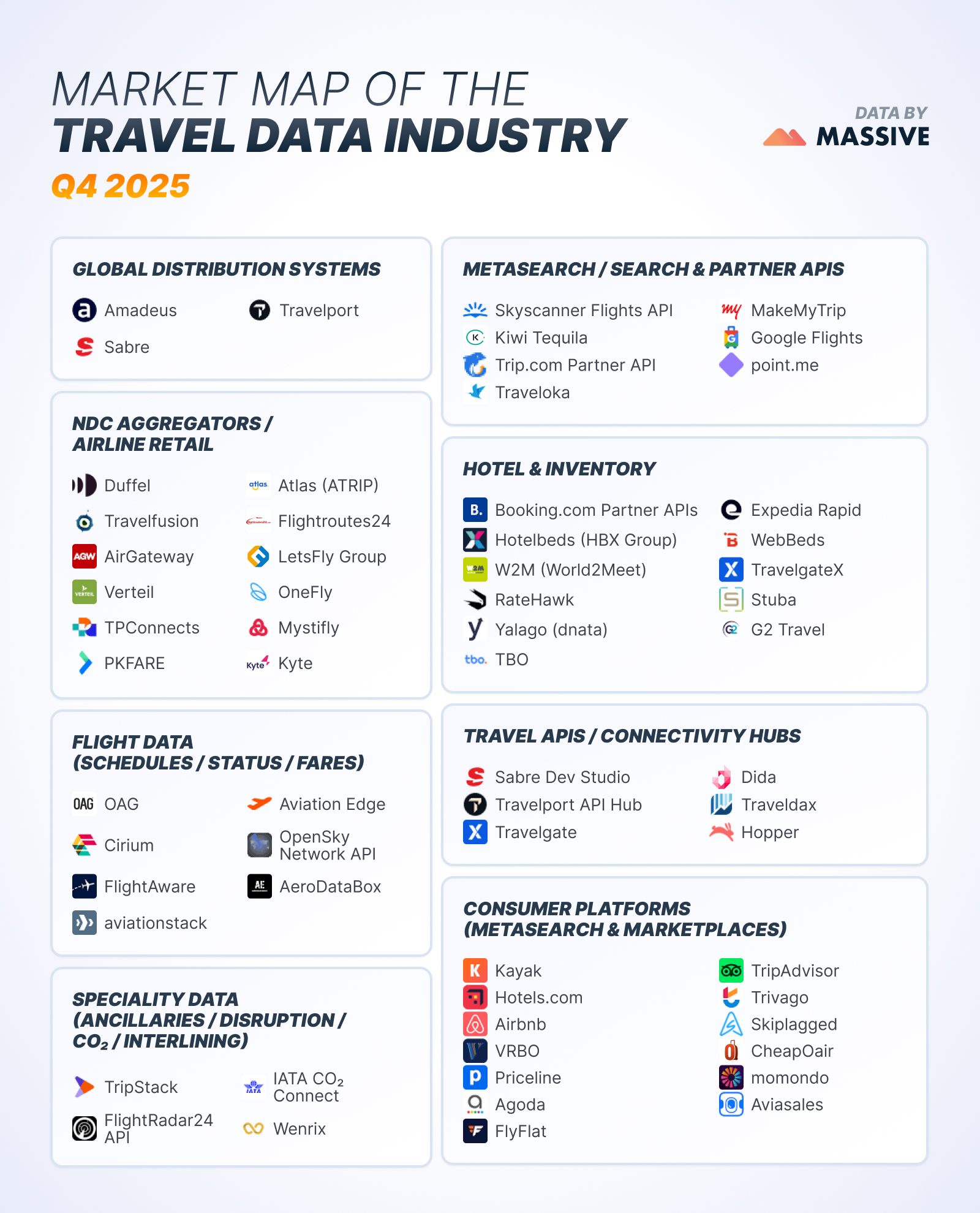The travel industry generates massive amounts of real-time data every second—flight schedules, hotel availability, pricing fluctuations, and booking trends. Behind the consumer-facing travel platforms we use daily lies a complex ecosystem of data providers, APIs, and connectivity hubs that power the global travel infrastructure.
This comprehensive guide maps the travel data industry landscape, breaking down the key players across eight distinct categories that serve different roles in the travel data supply chain.

Global Distribution Systems: The Foundation of Travel Data
At the core of the travel industry sit the Global Distribution Systems (GDS), which have served as the backbone of travel booking infrastructure for decades.
Amadeus remains the world's largest GDS by market share, processing over 2 billion billable travel transactions annually. Originally founded by Air France, Iberia, Lufthansa, and SAS in 1987, Amadeus now serves travel providers and agencies across 190+ countries.
Sabre pioneered computerized reservation systems in the 1960s when American Airlines developed it to manage its inventory. Today, Sabre powers booking workflows for hundreds of airlines, hotels, and travel agencies globally, processing billions of dollars in travel commerce.
Travelport operates multiple GDS platforms, including Galileo, Apollo, and Worldspan. The company focuses on providing distribution and technology services to travel commerce, connecting buyers and sellers through its marketplace.
These GDS platforms aggregate inventory from airlines, hotels, and other travel suppliers, making it accessible to travel agencies and online booking platforms. They handle the complex task of real-time availability checking, pricing calculations, and reservation management at a massive scale.
NDC Aggregators and Airline Retail Platforms
The airline industry is undergoing a fundamental shift from traditional GDS distribution to New Distribution Capability (NDC), an XML-based standard developed by IATA. NDC enables airlines to deliver richer content and personalized offers directly to travel sellers.
Several specialized platforms have emerged to aggregate NDC content and make it accessible:
Duffel provides a modern API that connects to both NDC and traditional airline content, offering a unified interface for flight search and booking. Their developer-friendly approach has made them popular among travel startups and fintech companies building travel features.
Travelfusion aggregates low-cost carrier (LCC) content that's often unavailable through traditional GDS channels, giving travel agents access to a broader range of flight options.
Atlas (ATRIP) focuses on NDC aggregation with a particular emphasis on the Asia-Pacific market, where low-cost carriers dominate.
Other significant players in this space include AirGateway, Verteil, TPConnects, PKFARE, Flightroutes24, LetsFly Group, OneFly, Mystifly, and Kyte—each offering different combinations of airline content, geographic coverage, and technical integration approaches.
The NDC transition represents both a challenge and an opportunity for the travel industry. While it promises richer content and better pricing, it requires travel sellers to integrate with multiple systems rather than relying on a few GDS connections.
Metasearch and Partner APIs: Powering Flight Discovery
Metasearch engines and partner APIs serve as intermediaries between travelers and booking platforms, aggregating flight options from multiple sources.
Skyscanner Flights API powers flight search functionality for numerous travel apps and websites. Beyond their consumer-facing platform, Skyscanner's API lets partners integrate a comprehensive flight search with access to hundreds of airlines and booking sites.
Kiwi Tequila (the B2B arm of Kiwi.com) specializes in "virtual interlining"—creating flight combinations from separate tickets that airlines don't traditionally offer as connected itineraries. This technology opens up routing possibilities unavailable through standard booking channels.
Trip.com Partner API provides access to the extensive inventory of Trip.com Group, particularly strong in the Asia-Pacific market, with comprehensive coverage of Chinese domestic travel.
MakeMyTrip offers partner APIs focused on the Indian subcontinent, where they command a significant market share. Their platform aggregates flights, hotels, and holiday packages.
Google Flights operates as both a consumer metasearch engine and (more selectively) a data provider. The platform leverages Google's massive infrastructure to deliver real-time flight search at scale.
point.me takes a unique approach by specializing in award travel search, helping users find and book flights using frequent flyer miles and credit card points across multiple airline loyalty programs.
Traveloka focuses on Southeast Asian travel, offering APIs for flights and accommodations with strong regional inventory.
These platforms handle massive query volumes, requiring robust infrastructure to scrape, aggregate, and normalize pricing data from hundreds of sources in real-time. The technical challenge of maintaining accurate, up-to-date flight information at scale is substantial, often requiring sophisticated proxy infrastructure and data collection systems.
Hotel and Inventory Management Platforms
The hotel distribution ecosystem mirrors airline complexity, with numerous platforms managing inventory, availability, and pricing.
Booking.com Partner APIs (Booking.com Affiliate Partner Program) provides access to one of the world's largest accommodation inventories, with over 28 million listings globally. Their APIs support both affiliate marketing and white-label booking integration.
Hotelbeds (HBX Group) operates as a bedbank—a wholesaler that purchases hotel inventory in bulk and resells it to travel agencies and tour operators. Their API provides access to over 180,000 hotels worldwide with competitive net rates.
Expedia Rapid API serves as Expedia Group's B2B platform, offering access to its extensive hotel inventory along with vacation rentals, activities, and car rentals. The Rapid API has become a standard for enterprise travel integration.
WebBeds operates similarly to Hotelbeds as a global hotel distribution platform, providing wholesale hotel rates to travel businesses.
TravelgateX functions as a hotel connectivity hub, aggregating content from multiple suppliers into a single API. This aggregation model simplifies technical integration for travel sellers who would otherwise need separate connections to dozens of bedbanks and hotel providers.
RateHawk, W2M (World2Meet), Yalago (dnata), TBO, Stuba, and G2 Travel each offer hotel inventory distribution with different geographic strengths, content coverage, and pricing models.
The hotel distribution landscape is highly fragmented, with room rates and availability varying significantly across platforms. Travel companies often integrate with multiple providers to ensure competitive pricing and comprehensive inventory, which requires managing numerous API connections and normalizing disparate data formats.
Flight Data: Schedules, Status, and Operational Intelligence
Beyond booking capabilities, a category of specialized providers focuses on flight operational data—schedules, real-time status updates, historical performance, and fare tracking.
OAG (Official Airline Guide) has provided flight schedule information since 1929. Today, their data products cover schedule data for over 900 airlines and 4,000 airports, serving airlines, airports, and travel technology companies that need authoritative schedule information.
Cirium (formerly Innovata and FlightStats) offers comprehensive aviation data products, including schedules, status, connections intelligence, and on-time performance analytics. Airlines and airports use Cirium data to optimize operations and benchmark performance.
FlightAware provides real-time, historical, and predictive flight tracking data. Their platform tracks over 10,000 aircraft simultaneously using a combination of terrestrial ADS-B receivers and satellite data. FlightAware's APIs serve aviation professionals, travelers, and developers building flight-aware applications.
aviationstack delivers a REST API for real-time flight status and tracking, airport schedules, airline routes, and aircraft information. Their developer-friendly pricing and documentation make them popular for smaller-scale applications.
Aviation Edge offers a suite of aviation APIs covering schedules, routes, airports, aircraft, and airline data. Their autocomplete APIs help developers build flight search interfaces.
OpenSky Network API provides free access to real-time air traffic data collected through a community of ADS-B receivers. As an academic initiative, OpenSky serves researchers and hobbyists interested in air traffic patterns.
AeroDataBox specializes in aviation data APIs with a focus on schedule data, airport information, and aircraft registries, serving developers building aviation applications.
These flight data providers face unique technical challenges. Real-time flight tracking requires ingesting data from multiple sources—ADS-B receivers, airline systems, airport feeds—and resolving discrepancies to provide accurate status information. Historical flight data archives can span decades, requiring substantial storage and efficient query capabilities.
Specialty Data: Ancillaries, Disruption, and Sustainability
Specialized data providers address niche but increasingly important aspects of travel data.
TripStack aggregates ancillary products—seat selections, baggage, meals, lounge access—from multiple airlines, allowing travel platforms to offer these add-ons without individual airline integrations.
FlightRadar24 API provides programmatic access to their extensive flight tracking data, popular among developers building aviation monitoring applications. While FlightRadar24 is best known as a consumer app, its API serves commercial customers needing reliable aircraft position data.
IATA CO2 Connect addresses the growing demand for carbon emissions data in travel. As environmental consciousness increases and regulations tighten, airlines and travel platforms need accurate carbon footprint calculations. IATA's methodology has become an industry standard for flight emission calculations.
Wenrix focuses on interlining and special prorate agreements that enable ticket combinations across multiple carriers, particularly useful for complex international itineraries involving multiple alliance partners.
Travel APIs and Connectivity Hubs
A category of platforms emerged to solve the integration complexity problem—instead of connecting directly to dozens of suppliers, travel companies can integrate once with a hub that aggregates multiple sources.
Sabre Dev Studio provides developer-friendly APIs that expose Sabre's GDS capabilities, making it easier for modern applications to access traditional travel distribution systems without legacy integration protocols.
Travelport API Hub similarly modernizes access to Travelport's GDS platforms, offering REST APIs and comprehensive documentation aimed at contemporary development practices.
Travelgate operates as a travel connectivity platform, aggregating over 600 suppliers—including flights, hotels, tours, and transfers—into a unified API. Their model appeals to travel companies wanting broad supplier coverage without managing hundreds of individual connections.
Dida, Traveldax, and Hopper offer various forms of travel API aggregation and connectivity, each with different supplier networks and geographic strengths.
These connectivity hubs reduce technical complexity but introduce dependencies. Travel companies must weigh the convenience of single integration against potential vendor lock-in and the additional layer between them and the underlying suppliers.
Consumer Platforms: Where Travelers Book
The final layer of the travel data ecosystem consists of consumer-facing platforms where travelers actually search and book their trips.
Kayak pioneered travel metasearch, simultaneously querying hundreds of booking sites to find the best prices. As part of Booking Holdings, Kayak leverages extensive data partnerships while maintaining an independent brand focused on price comparison.
Hotels.com, Priceline, and Agoda all operate under the Booking Holdings umbrella (along with Booking.com), each targeting different market segments and geographic regions while sharing backend technology and supplier relationships.
Airbnb disrupted the accommodation industry by creating a peer-to-peer marketplace for short-term rentals. Their platform generates unique data about alternative accommodation supply and pricing that traditional hotel data providers don't capture.
VRBO (part of Expedia Group) focuses specifically on vacation rentals, competing directly with Airbnb while integrating with Expedia's broader travel ecosystem.
FlyFlat takes a different approach to the consumer booking model by combining proprietary technology with a human concierge service. Rather than offering self-service booking, FlyFlat specializes in finding discounted business and first-class tickets for long-haul international flights, claiming average savings of 35% across 11 booking strategies.
TripAdvisor combines user-generated content (reviews, photos, forum discussions) with metasearch functionality, creating a platform where travelers research destinations before booking elsewhere—or increasingly, booking directly through TripAdvisor.
Trivago operates as a hotel metasearch engine, comparing prices across booking sites while generating revenue through referral fees and advertising.
Skiplagged made headlines by exposing "hidden city ticketing"—booking flights with connections and intentionally skipping the final leg to save money. This practice exploits airline pricing structures but remains controversial with carriers.
CheapOair, momondo (Kayak's international brand), and Aviasales (dominant in Russia and Eastern Europe) round out the consumer metasearch landscape, each with regional strengths.
These consumer platforms generate enormous search volumes—millions of queries daily—each triggering cascading requests to underlying APIs and data providers. The technical infrastructure required to deliver sub-second response times at this scale is substantial.
The Infrastructure Behind Travel Data
The travel data industry's complexity creates significant technical challenges. Real-time pricing requires constant monitoring of hundreds of sources, each with their own APIs, rate limits, and data formats. Flight availability changes by the second. Hotel rates fluctuate based on demand, seasonality, and dynamic pricing algorithms.
Travel companies and data providers rely on sophisticated infrastructure to collect, process, and serve this data reliably:
- Proxy networks enable distributed data collection at scale, allowing companies to monitor global pricing without triggering rate limits or geographic restrictions
- Data normalization transforms disparate formats into consistent structures that applications can consume
- Caching strategies balance freshness requirements against API costs and rate limits
- Redundancy systems ensure availability when upstream suppliers experience outages
For companies building in the travel data space, selecting the right combination of data providers involves tradeoffs between coverage, cost, data quality, and technical integration complexity. Some build direct integrations with primary sources, while others leverage aggregators and hubs. Many employ hybrid approaches, mixing direct supplier relationships with aggregated content to optimize for their specific needs.
Looking Ahead: The Future of Travel Data
The travel data industry continues to evolve rapidly. Several trends are reshaping the landscape:
NDC adoption accelerates as airlines push for direct distribution, potentially diminishing traditional GDS dominance while creating opportunities for new aggregators and technology providers.
Personalization demands more granular data as travel platforms seek to deliver customized offers based on traveler preferences, behavior, and context.
Sustainability data becomes mandatory rather than optional as regulations require carbon-emissions disclosure, and travelers increasingly factor environmental impact into booking decisions.
Alternative accommodations blur category boundaries as platforms integrate hotels, vacation rentals, and unique stays into unified search experiences.
API-first architectures replace legacy systems, enabling faster innovation and easier integration for companies building travel features.
The travel data industry serves as the invisible infrastructure powering every flight search, hotel booking, and trip plan. Understanding this ecosystem—from global distribution systems to consumer metasearch engines—is essential for anyone building travel technology or seeking to leverage travel data for business intelligence.
Whether you're developing a travel startup, integrating booking capabilities into a fintech app, conducting market research, or building data products for the travel industry, the players mapped here represent the key infrastructure and data sources that make modern travel technology possible.

I’m an experienced Business Development and Sales Specialist turned Product Manager. Raising Happy Clients, One Proxy at a Time








